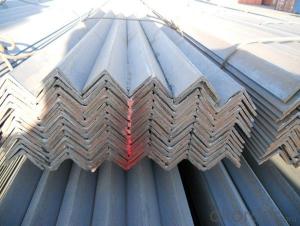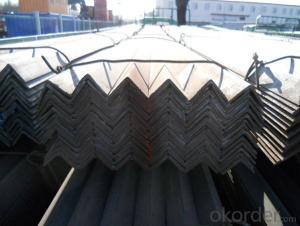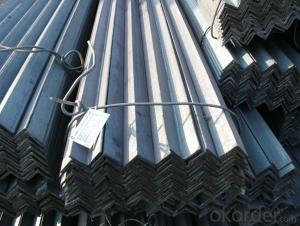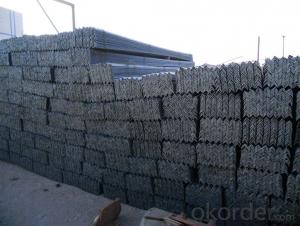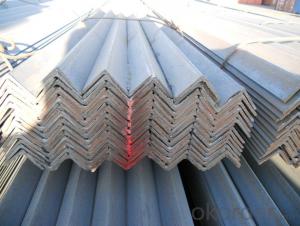High Quality Steel Angle Beams for Structure of Construction
- Loading Port:
- Tianjin
- Payment Terms:
- TT or LC
- Min Order Qty:
- 25 m.t.
- Supply Capability:
- 200000 m.t./month
OKorder Service Pledge
OKorder Financial Service
You Might Also Like
Product Description:
OKorder is offering High Quality Steel Angle Beams for Structure of Construction at great prices with worldwide shipping. Our supplier is a world-class manufacturer of steel, with our products utilized the world over. OKorder annually supplies products to African, South American and Asian markets. We provide quotations within 24 hours of receiving an inquiry and guarantee competitive prices.
Product Applications:
High Quality Steel Angle Beams for Structure of Construction are ideal for structural applications and are widely used in the construction of buildings and bridges, and the manufacturing, petrochemical, and transportation industries.
Product Advantages:
OKorder's High Quality Steel Angle Beams for Structure of Construction are durable, strong, and wide variety of sizes.
Main Product Features:
· Premium quality
· Prompt delivery & seaworthy packing (30 days after receiving deposit)
· Can be recycled and reused
· Mill test certification
· Professional Service
· Competitive pricing
Product Specifications:
Manufacture: Hot rolled
Grade: Q195 – 235
Certificates: ISO, SGS, BV, CIQ
Length: 6m – 12m, as per customer request
Packaging: Export packing, nude packing, bundled
EQUAL ANGLES SIZES |
| ||
a(mm) | a1(mm) | thickness(mm) | length |
25 | 25 | 2.5---3.0 | 6M/12M |
30 | 30 | 2.5---4.0 | 6M/12M |
38 | 38 | 2.5 | 6M/12M |
38 | 38 | 3.0---5.0 | 6M/12M |
40 | 40 | 3.0---6.0 | 6M/12M |
50 | 50 | 3 | 6M/12M |
50 | 50 | 3.7---6.0 | 6M/9M/12M |
60 | 60 | 5.0---6.0 | 6M/9M/12M |
63 | 63 | 6.0---8.0 | 6M/9M/12M |
65 | 65 | 5.0---8.0 | 6M/9M/12M |
70 | 70 | 6.0---7.0 | 6M/9M/12M |
75 | 75 | 5.0---10.0 | 6M/9M/12M |
80 | 80 | 6.0---10.0 | 6M/9M/12M |
90 | 90 | 6.0---10.0 | 6M/9M/12M |
100 | 100 | 6.0---12.0 | 6M/9M/12M |
120 | 120 | 8.0-12.0 | 6M/9M/12M |
125 | 125 | 8.0---12.0 | 6M/9M/12M |
130 | 130 | 9.0-12.0 | 6M/9M/12M |
140 | 140 | 10.0-16.0 | 6M/9M/12M |
150 | 150 | 10---15 | 6M/9M/12M |
160 | 160 | 10---16 | 6M/9M/12M |
180 | 180 | 12---18 | 6M/9M/12M |
200 | 200 | 14---20 | 6M/9M/12M |
FAQ:
Q1: Why buy Materials & Equipment from OKorder.com?
A1: All products offered byOKorder.com are carefully selected from China's most reliable manufacturing enterprises. Through its ISO certifications, OKorder.com adheres to the highest standards and a commitment to supply chain safety and customer satisfaction.
Q2: How many tons of steel products could be loaded in containers?
A2: Usually the steel products are delivered by bulk vessel because of the large quantity and the freight. However, there are no bulk vessel enter some seaports so that we have to deliver the cargo by containers. The 6m steel product can be loaded in 20FT container, but the quantity is changed according to the size, usually from 18tons to 25tons.
Q3: what is the difference between actual weight and theoretical weight?
A3: All the section steel has two weights: actual weight and theoretical weight. Actual weight is the weighing out when the product delivered from the mill. Theoretical weight is calculated by pieces. The invoice can be based on each of them as your request.
Images:
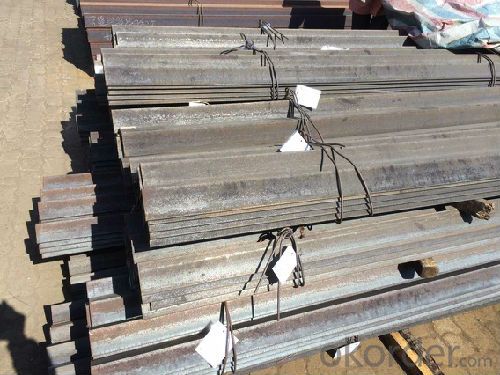
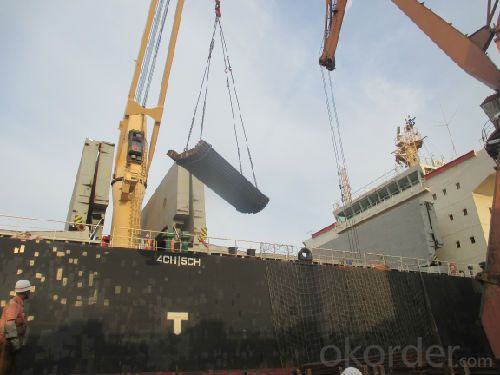
- Q:What does "L125*8" stand for in steel structures?
- Angle steel is divided into equal angle steel and unequal angle steel. The expression of the equal angle steel model is b*d, in which B is the unilateral width of the equilateral angle steel, and the D is the thickness, and the unit is MM. Unequal angles are named by the ratio of the length to the width of a centimeter and the width of a short edge. Therefore, the L125*8 represents an equilateral angle steel beam with a unilateral width of 125 and a thickness of 8. I hope this problem can be solved for you.
- Q:How do steel angles perform under seismic loads?
- Steel angles are commonly used in construction to provide structural support and reinforcement. When subjected to seismic loads, steel angles have been found to perform exceptionally well due to their inherent properties and design flexibility. One key advantage of steel angles is their high strength-to-weight ratio. This allows them to withstand the intense forces and movements generated during an earthquake without significant deformation or failure. The compact shape of the angle also helps distribute the load more efficiently, minimizing stress concentrations and potential weak points. Moreover, steel angles can be easily connected to other structural elements, providing a robust and reliable connection system. This is particularly important in seismic design, where the ability to transfer forces and accommodate movements is essential. To further enhance their performance under seismic loads, steel angles can be designed with specific features. For instance, the addition of stiffeners or bracing elements can increase their resistance to lateral forces, reducing the risk of buckling or collapse. Additionally, the use of thicker and stronger steel grades can improve their overall capacity to absorb and dissipate seismic energy. Various seismic design codes and standards provide guidelines and requirements for the use of steel angles in seismic-resistant structures. These codes consider factors such as the maximum allowable stress levels, detailing requirements for connections, and the overall structural behavior under seismic actions. In conclusion, steel angles perform admirably under seismic loads due to their high strength-to-weight ratio, efficient load distribution, and flexibility in design. When properly designed and implemented, steel angles can effectively resist the forces and movements generated during an earthquake, ensuring the structural integrity and safety of the building.
- Q:What are the different types of steel angles used in bridge construction?
- There are several types of steel angles commonly used in bridge construction. These angles play a crucial role in providing structural support and stability to the bridge. 1. Equal Leg Angles: Equal leg angles, also known as L-shaped angles, have two legs of equal length that form a 90-degree angle. These angles are used in bridge construction to provide support and reinforcement to the bridge components. 2. Unequal Leg Angles: Unequal leg angles, as the name suggests, have two legs of different lengths that form a 90-degree angle. These angles are commonly used in bridge construction to accommodate specific design requirements and support varying loads. 3. Bulb Angles: Bulb angles are special types of angles that have a bulb-shaped leg. These angles are used in bridge construction to provide additional strength and rigidity to the bridge structure, particularly in areas where high stress or heavy loads are anticipated. 4. Inverted Angles: Inverted angles are similar to equal leg angles, but the orientation is inverted, with the longer leg on the bottom. These angles are commonly used in bridge construction to provide additional support and stability, especially in situations where the bridge needs to withstand lateral forces. 5. Fillet Welded Angles: Fillet welded angles are angles that are joined together using fillet welds. These angles are used in bridge construction to create strong and durable connections between different bridge components, ensuring structural integrity and stability. Each type of steel angle has its unique properties and advantages, making them suitable for specific applications in bridge construction. The selection of the appropriate angle type depends on factors such as load requirements, span length, design specifications, and structural considerations. Professional engineers and designers carefully assess these factors to determine the best type of steel angle to be used in a specific bridge construction project.
- Q:What are the different methods of surface preparation for steel angles?
- There are several methods of surface preparation for steel angles in order to ensure proper adhesion of coatings, improve corrosion resistance, and enhance the overall durability of the material. Some of the common methods include: 1. Mechanical Cleaning: This involves using mechanical tools such as wire brushes, sandpaper, or abrasive discs to physically remove dirt, rust, mill scale, and other contaminants from the surface of the steel angles. This method is relatively simple and cost-effective but may not be suitable for heavy corrosion or stubborn deposits. 2. Chemical Cleaning: Chemical cleaning involves the use of acid-based solutions or pickling pastes to dissolve rust, scale, and other contaminants. The solution is applied to the surface and left for a specific period before being rinsed off. This method is highly effective in removing stubborn deposits but requires careful handling and proper disposal of the chemicals. 3. Power Tool Cleaning: Power tool cleaning utilizes power tools like grinders, sanders, or needle guns with abrasive attachments to remove rust, scale, and other contaminants. This method is faster and more efficient than manual mechanical cleaning, making it suitable for large-scale surface preparation. 4. Blast Cleaning: Blast cleaning, also known as abrasive blasting, involves propelling abrasive materials (such as sand, steel grit, or glass beads) at high velocity onto the steel surface using compressed air or centrifugal force. This method effectively removes rust, scale, and other contaminants, providing a clean and profiled surface. It is widely used in industrial applications but requires proper safety measures to protect workers from exposure to abrasive materials. 5. Flame Cleaning: Flame cleaning is a method where a high-temperature flame is directed onto the steel surface to remove contaminants. The intense heat burns off organic materials and evaporates moisture, leaving a clean surface. This method is particularly useful for removing oil, grease, and paint residues. 6. Conversion Coating: Conversion coating involves applying a chemical solution onto the steel surface, which reacts with the metal to form a thin protective layer. This layer enhances the adhesion of subsequent coatings and provides additional corrosion resistance. Common conversion coatings include phosphating, chromating, and passivation. It is important to note that the selection of the most appropriate surface preparation method depends on factors such as the extent of corrosion, the desired coating system, and the environmental conditions the steel angles will be exposed to. Consulting with experts or referring to industry standards can help determine the most suitable method for a specific application.
- Q:Can steel angles be used for stairs or handrails?
- Indeed, stairs or handrails can make use of steel angles. In construction, steel angles are frequently employed due to their ability to offer structural support and stability. In the case of stairs, steel angles can be integrated as stringers or supports, guaranteeing the staircase's stability and strength. Similarly, for handrails, steel angles can be utilized as the primary frame or support structure, ensuring a robust and secure handrail for users. The incorporation of steel angles in stairs and handrails presents advantages such as durability, resistance to deterioration, and the capacity to withstand heavy loads, which contribute to their popularity in construction endeavors.
- Q:Can steel angles be used in framing?
- Indeed, framing can incorporate steel angles. In construction, steel angles are frequently employed to provide structural support and reinforcement. These angles possess adaptability, allowing for simple welding, bolting, or screwing together to construct frames suited for diverse purposes. By incorporating steel angles, structures gain both strength and stability, rendering them suitable for framing walls, ceilings, floors, and other structural elements. Moreover, steel angles are accessible in various sizes and thicknesses, permitting flexibility in design and construction. Ultimately, steel angles are a favored option in framing due to their enduring nature, versatility, and structural characteristics.
- Q:Can steel angles be used as decorative elements?
- Yes, steel angles can definitely be used as decorative elements. Steel angles, also known as L-shaped metal profiles, can add a touch of industrial or modern aesthetic to any space. They can be used in various ways to enhance the overall design and appearance of a room or outdoor area. One popular use of steel angles as decorative elements is in architectural and interior design. They can be used as trim or edging on walls, ceilings, or furniture, adding a unique and stylish look. Steel angles can also be used to create interesting patterns or designs on surfaces, such as herringbone or chevron patterns, adding visual appeal and a contemporary feel. In addition, steel angles can be used as decorative supports or brackets for shelves, countertops, or other fixtures. They not only provide structural support but also add a modern and industrial touch to the overall design. Steel angles can be painted or powder-coated in different colors to match the desired aesthetic, further enhancing their decorative appeal. Moreover, steel angles can be used in outdoor spaces as decorative elements. They can be incorporated into fences, gates, or railings, providing a durable and stylish solution. Steel angles can also be used as decorative accents in landscaping, such as creating borders or outlining flower beds, adding a touch of modern design to the outdoor environment. Overall, steel angles offer a versatile and attractive option for incorporating decorative elements into various design projects. Their sleek and industrial look, combined with their strength and durability, make them a popular choice for both interior and exterior decorative purposes.
- Q:How are steel angles protected against fire damage?
- Steel angles are commonly protected against fire damage through the application of fire-resistant coatings or the use of fireproofing materials. These protective measures aim to delay or prevent the steel from reaching its critical temperature, at which it may lose its structural integrity. One common method of protecting steel angles is the application of intumescent coatings. These coatings expand when exposed to high temperatures, forming a protective char layer that insulates the steel and slows down heat transfer. This process effectively delays the rise in temperature of the steel, allowing for longer fire resistance. Another approach is the use of fireproofing materials, such as concrete or gypsum-based sprays or boards. These materials create a barrier between the steel angles and the fire, providing insulation and preventing the heat from reaching the steel. Fireproofing materials are often used in buildings where the fire resistance requirements are higher, such as high-rise structures or industrial facilities. In some cases, steel angles can also be protected by encasing them in fire-rated enclosures. This involves enclosing the steel angles within fire-rated walls, floors, or ceilings made of materials with high fire resistance. These enclosures effectively isolate the steel from potential sources of fire and provide an additional layer of protection. It is important to note that the specific fire protection measures for steel angles may vary depending on the building codes, fire safety regulations, and the intended use of the structure. Consulting with fire protection engineers and following the appropriate guidelines can ensure that the steel angles are adequately protected against fire damage.
- Q:What are the different types of connections used for steel angles in marine applications?
- In marine applications, the different types of connections used for steel angles include bolting, welding, and adhesives. Bolting involves using bolts and nuts to secure the angles together, providing a strong and easily disassembled connection. Welding involves melting the steel angles together, creating a permanent and reliable connection. Adhesives, such as epoxy or polyurethane, are also used to bond the steel angles, offering a lighter weight and corrosion-resistant connection. Each type of connection has its advantages and suitability depending on the specific marine application and requirements.
- Q:What is the difference between hot-rolled and cold-rolled steel angles?
- Two distinct methods, hot-rolling and cold-rolling, are employed in the production of steel angles, resulting in varying characteristics. Hot-rolling involves heating a steel billet or ingot to a high temperature and subsequently passing it through a series of rollers. This process allows for the metal to be shaped and formed while it retains its malleability and pliability. Consequently, hot-rolled steel angles possess a coarser surface finish and less precise dimensions when compared to their cold-rolled counterparts. However, their strength and durability are generally superior, rendering them appropriate for structural applications necessitating high strength and load-bearing capacity. Conversely, cold-rolling entails passing hot-rolled steel through a sequence of rollers at room temperature. This procedure not only refines the dimensions and surface finish of the steel angles but also enhances their strength and hardness. Cold-rolled angles exhibit a smoother surface finish and more accurate dimensions, making them ideal for applications requiring precise fitting or a polished appearance. They are commonly employed in architectural and decorative endeavors, as well as in industries where aesthetics and precision are paramount. To summarize, the primary disparities between hot-rolled and cold-rolled steel angles lie in their manufacturing processes, surface finishes, dimensional accuracy, and applications. Hot-rolled angles are stronger and rougher, rendering them suitable for structural purposes, whereas cold-rolled angles possess a smoother finish and precise dimensions, making them more appropriate for decorative and architectural applications.
1. Manufacturer Overview |
|
|---|---|
| Location | |
| Year Established | |
| Annual Output Value | |
| Main Markets | |
| Company Certifications | |
2. Manufacturer Certificates |
|
|---|---|
| a) Certification Name | |
| Range | |
| Reference | |
| Validity Period | |
3. Manufacturer Capability |
|
|---|---|
| a)Trade Capacity | |
| Nearest Port | |
| Export Percentage | |
| No.of Employees in Trade Department | |
| Language Spoken: | |
| b)Factory Information | |
| Factory Size: | |
| No. of Production Lines | |
| Contract Manufacturing | |
| Product Price Range | |
Send your message to us
High Quality Steel Angle Beams for Structure of Construction
- Loading Port:
- Tianjin
- Payment Terms:
- TT or LC
- Min Order Qty:
- 25 m.t.
- Supply Capability:
- 200000 m.t./month
OKorder Service Pledge
OKorder Financial Service
Similar products
New products
Hot products
Hot Searches
Related keywords
